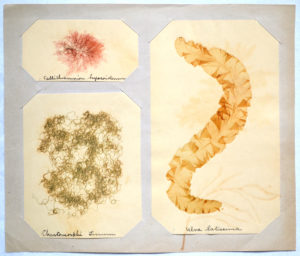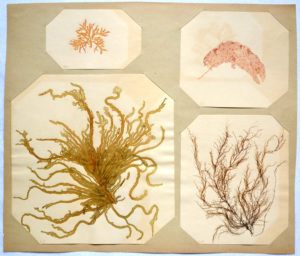
Marien Catherine Carry (1880-1968) gathered these seaweeds as a teenager in Newport. In 1957 she donated her dried seaweeds to the Newport Marine Museum, a one-time branch of the Newport Historical Society.
Newport farmers long prized seaweed as fertilizer. Rather than contemplate each strand, they raked it, heaped it, and carted it away. The mid-19th century saw seaweed take on a new purpose as people began collecting it as a hobby in Newport. By transforming tangles of algae into delicate specimens, collectors expressed their appreciation of the natural world.
Seaweed collectors took to the shore. They scrambled over rocks and used wire skimmers and fruit jars to capture specimens. “A spice of danger does not deter the heroic algologist,” declared one guidebook. These forays offered fresh air, exercise, and a sense of purpose. Collectors could enjoy free time without lapsing into idleness. Religion motivated some collectors. By examining algae, pious naturalists felt they could better fathom God’s creation.
Seaweed enthusiasts tended to be women with leisure time to spend outdoors. Unlike stuffing dead animals, preserving seaweed seemed a gentle pastime, ideal for female naturalists. They sought to blend the pleasures of the shore with the wholesome goal of self-improvement.
Seaweed served as art and science, specimen and souvenir. Collectors “floated out” fronds of wet seaweed on paper. They then pressed the algae between heavy objects to dry. Some seaweeds oozed a natural adhesive, while others required gluing.

These specimens belonged to the Newport Natural History Society, a group active from 1883 to about 1915. They drifted to the Newport Historical Society through a 1940 gift from Hugh Taylor. Taylor had once served as assistant curator of the natural history museum.
A collector might label her specimens with their Latin names. To classify seaweeds honed one’s powers of observation and knowledge of marine botany. Collectors often arranged their algae in albums. Displayed in the parlor, seaweeds became mementos of days by the shore. Others donated their dried seaweed collections — called herbaria — to museums. There, researchers and the public could access a rich diversity of aquatic plants.
With the acceptance of fun for its own sake, seaweed collecting lost appeal. Today, local scientists find new relevance in the practice. As new varieties appear in Rhode Island waters, marine biologists use seaweed to track changes in the environment. They combine traditional herbarium techniques with DNA sequencing to identify algae.
This post was adapted from the exhibit Flowers of the Ocean: A History of Seaweed Collecting in Newport curated by Kathrinne Duffy 2014 NHS Buchanan Burnham Fellow.
Banner: A photographic print of a group gathered on the rocks of the Cliff Walk, circa 1895. P4518, Collection of the Newport Historical Society.